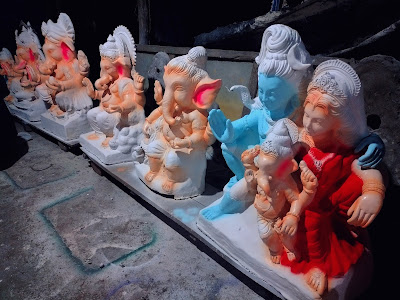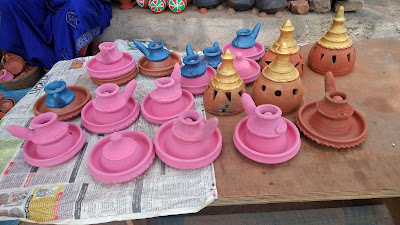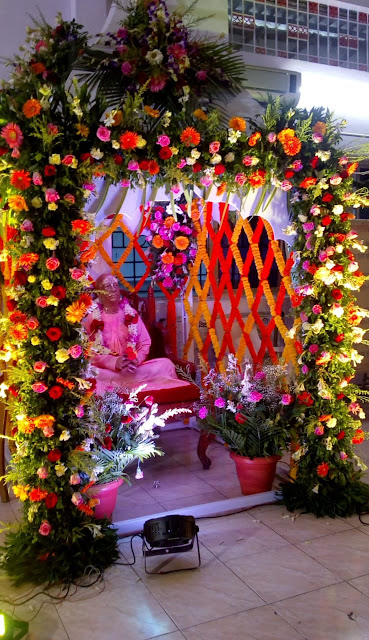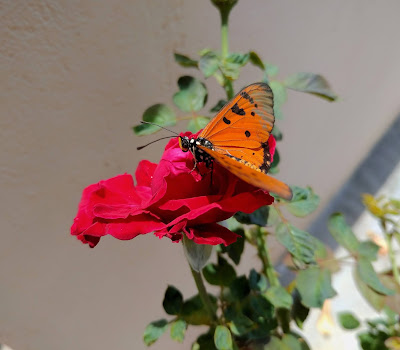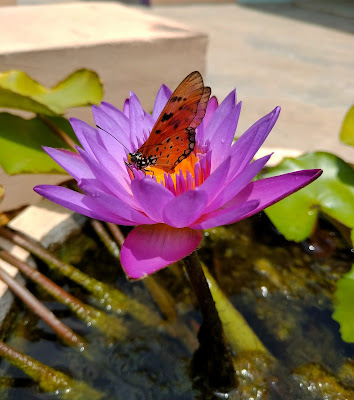Ganesh Chaturthi Special blog - Part 1
ॐ एकदन्ताय विद्महे वक्रतुंडाय धीमहि तन्नो बुदि्ध प्रचोदयात।।
Hi there! and a very happy Ganesh Utsav to you and your family! 🙏🌺
It was my dream since childhood to visit a potter's home or workshop before Ganesh- utsav or Durga Puja to see the statues before the world and capture the beauty and essence of it. I wondered how beautifully the photographers captured the beauty of half finished statues, by seeing pictures in the newspaper or internet. And Voila, this time, this dream of mine came true . I visited one of the potter's house in Bagbahra during this time and here are the glimpses of my visit, highly loaded with a combo of spirituality and art. Literally, it was a divine experience....
Ganesha, the son of Lord Shiva and Devi Parvati is popularly worshipped under different names like Sumukha, Ekadanta, Kapila, Gajakarna, Lambodara, Vikath, Vidhnanashaka, Vinayaka, Dhumraketu, Ganadhayaksha, Bhalchandra and Gajanana.
Ganesha’s form is highly charming and mesmerizing. The cute little chubby boy like body with an elephant head, a broken tusk. A rounded body carrying the wisdom of the universe. A tray of sweets by his side. A tiny mouse on the other. A lotus in one hand. A crown on his head. The second arm raised with an axe. A third lifting in benediction and blessing, has been inspiring devotion and love in the hearts of millions down the history. While the form of Lord Ganesh evokes our imaginations and pleases us beyond compare, there is also deep spiritual symbolism behind the form of Lord Ganesh.
Interesting symbolism behind Lord Ganesha's form -
Usually elephants are the path makers in forests. When an elephant passes through thick woods, a way is created for the other animals to follow. Lord Ganesh is worshiped first before starting anything new. Lord Ganesha clears the obstacles and paves the way for us to move forward in life.
The large elephant head of Lord Ganesha symbolizes wisdom, understanding, and a discriminating intellect that one must possess to attain perfection in life.
The wide mouth represents the . natural human desire to enjoy life in the world. The large ears signify that a perfect person is the one who possesses a great capacity to listen to others and assimilate ideas. Ganesha being the ruler of the worlds, he possesses large ears to keenly listen to the prayers and needs of all his subjects.
The trunk can hold anything and everything existent in this universe. Likewise, the individuals should possess qualities of high adaptability and efficiency in life. This in other words can make them attune to any circumstances of life. It also represents OM ( ॐ) the sound symbol of cosmic reality.
The two tusks denote the two aspects of the human personality, wisdom and emotion. The right tusk represents wisdom and the left tusk represents emotion. The broken left tusk conveys the idea that one must conquer emotions with wisdom to attain perfection.
The right foot dangling over the left foot illustrates that in order to live a successful life one should utilise knowledge and reason to overcome emotions.
The elephant eyes are said to possess natural deceptiveness that allows them to perceive objects to be bigger than what they really are. Thus it indicates to surrender one's pride and attain humility.
The Trishul (weapon of Shiva, similar to Trident) over forehead symbolises time (past, present and future) and Lord Ganesha's mastery over it.
The four arms of Lord Ganesha represent the four inner attributes of the subtle body, that is: mind (Manas), intellect (Buddhi), ego (Ahamkara), and conditioned conscience (Chitta). Lord Ganesha represents the pure consciousness - the Atman - which enables these four attributes to function in us. The hand waving an axe is a symbol of the retrenchment of all desires, bearers of pain and suffering.
With this axe Lord Ganesha can both strike and repel obstacles. The axe is also to prod man to the path of righteousness (dharma) and truth. The second hand holds a whip, symbol of the force that ties the devout person to the eternal beatitude of God. The whip conveys that worldly attachments and desires should be rid of; the third hand, turned towards the devotee, is in a pose of blessing, refuge and protection (abhaya); the fourth hand holds a lotus flower (padma), and it symbolizes the highest goal of human evolution, the sweetness of the realized inner self.
The human body possesses a human heart, which is a symbol of kindness and compassion toward all. Lord Ganesha is usually portrayed wearing red and yellow clothes. Yellow symbolizes purity, peace, auspiciousness, sense control, and truthfulness. Red symbolizes the activity in the world. Thus an individual should perform all duties in the world, with purity, peace, and truthfulness.
Lord Ganesha's belly represents the whole cosmos, the seven realms above and below and the seven oceans are inside Ganesha's cosmic belly. These are held together by the cosmic energy (kundalini) symbolized by the huge snake around him. The snake that runs round his waist represents energy in all forms. The big belly signifies that a person should face all pleasant and unpleasant experiences during his life span with patience and calmness.
The mouse represents ego. Lord Ganesha using the mouse represents the need to control ego and so it's said that one who controls his ego has Ganesha consciousness. Ganesh Chaturthi is a celebration of The Lord who controls the universe. The wandering mouse also signifies the wavering human mind. As Lord Ganesh (elephant head) controls the mouse, we must also learn to control our mind with intellect.
Yet another interpretation explains why Lord Ganesh has the mouse as his vehicle. The king must be accessible to all the subjects equally. Ganesh with a huge body and elephant head is close to the mouse which is a tiny creature. This indicates all lives are equal and it is the duty of every human to take care of the humble lives around.
Photographist : Kamya 📸
Facts curated from various websites...
Mouse also symbolizes uncontrolled desires and ego that can nibble all that is good and noble in a person. A mouse sitting near the feet of lord Ganesha and gazing at the Laddus denotes that with purified or controlled desires one can live in the world without being affected by the worldly temptations.
See you in the next blog soon, till then,
Have a wonderful day, take care and....
always remember to love yourself first!! ❤
May lord Ganesha give you a rainbow for every storm, a smile for every tear. A promise for every care and an answer to every prayer. Wishing you a happy Ganesh Paksh. ❤️🙏🏼✨
